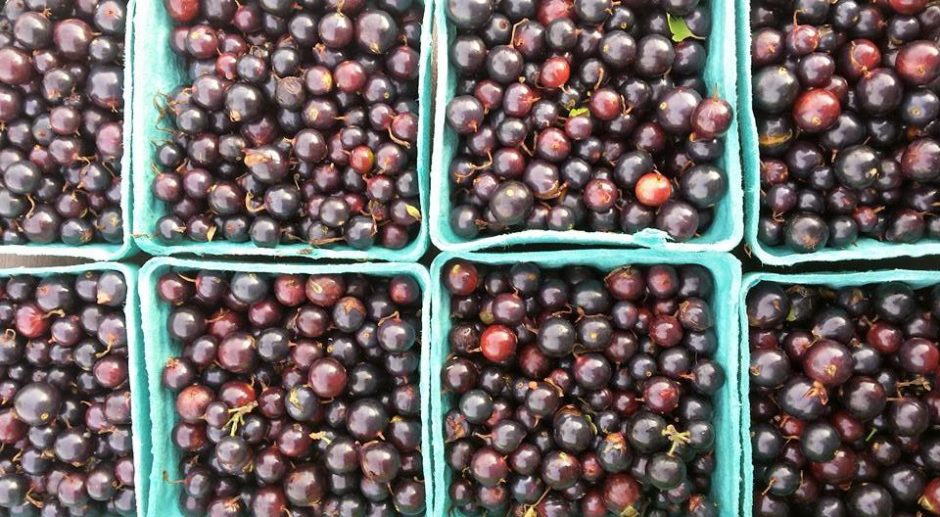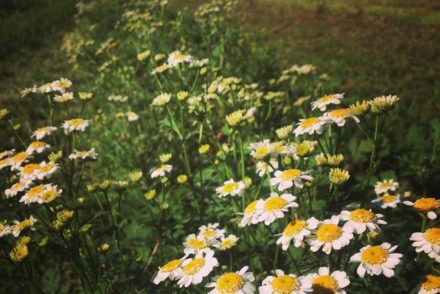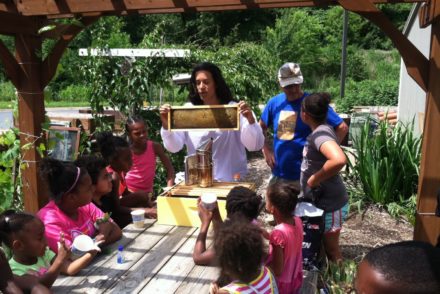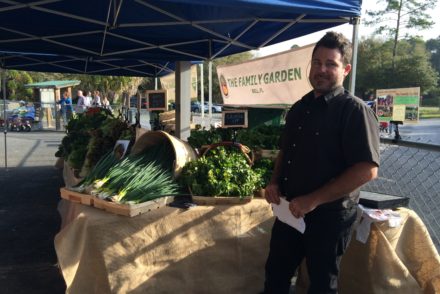“I lost the belief in farming as something I could actually do with my life. Because I had a lot of academic aptitude, and because I didn’t come from a farming or entrepreneurial family, there was a sense that a professional, egg-heady, indoor life was what was expected and supported by those around me and became what I expected of myself, as well.”
Katie Kenney abandoned childhood dreams of farming for a career as an academic. That career took her to Central Illinois, where amid fields of soy and corn, she rekindled her desire to grow food—not in long, straight lines, but in a patchwork of plants and livestock. Katie shares why and how she transitioned from working as a full-time university professor to running a small, diversified farm.
Describe your farm.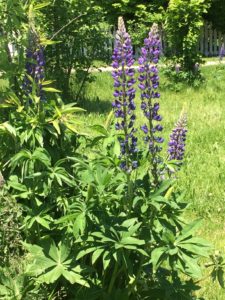
Stone Court Farm is a tiny oasis of diversity in a sea of corn and soybeans. We have only 3.8 acres
, actually, but the place is packed!
We are a diversified, sustainable micro-farm in Mahomet, IL, offering a range of natural products, from pasture-raised lamb, pork, chicken and eggs, to asparagus, rhubarb and berries.
This is our second year marketing our products at The Land Connection’s Champaign Farmers’ Market and our fourth year of marketing direct to customers who visit our farm or place orders with us for shares of meat or eggs.
While we’re not certified organic, we follow organic and “beyond-organic” practices, using no chemical fertilizers or pesticides.
We are in Central Illinois, where the soil is absolutely amazing, which makes growing things incredibly easy. I can easily plant 50 trees and/or berry bushes in a day (well, my back was pretty sore after that day, so maybe not so easily), because it’s like digging in devil’s food cake.
We bought our place in 2004, but we had to move away for work for several years, so we only got back here and really got started farming in 2012. I am very interested in no-till, permaculture-type models that combine different plants and integrate plants and animals. One of the first things I did was plant asparagus, rhubarb, and my first fruit trees. Then, while those plants have been maturing, I have focused more effort on the animal side, raising pastured broiler chickens, sheep, and (in most years) a few pigs. We also have dairy goats for our own family use.
I sell the meat to individual customers—whole or half lambs, kids, or pigs, as well as the broilers. Most of those people have been friends or family, and because the place is so small, I haven’t tried to expand that part of the operation.
Meanwhile, when the rhubarb and asparagus started producing, I was lucky that my farmer friend who was in the farm beginnings class with me, and who was doing a vegetable operation, was willing to sell my stuff at her table at farmers’ market (I shared the cost of the table, and the market allowed us to do it). I didn’t have enough to make it worth it to get my own table, so that was really helpful.
This year, I’ve had to change things up, because that friend quit her own operation to go to work at a larger farm. Now I’m sharing a table with another farmer neighbor, but I actually have to go and staff the table. This year, more of my fruiting plants are maturing and producing. In addition to the rhubarb and asparagus, I have strawberries to sell now, and will have gooseberries, currants, peaches, plums, quinces, and apples, assuming all goes well with weather and everything else!
I realized when I looked at all that fruit coming up, and thought about how little time I have (I have three kids, including a one-year-old baby), that if I wasn’t going to have fruit rotting on the bushes and trees, I was going to have to have help picking this year. So I have just started a once-a-week Pick Your Own (which I may extend to two days a week). At first, I just announced this on the farm’s Facebook page. Nobody came. Next, I created an event page for it and invited ALL of my local Facebook friends (who live in the nearby college town, mostly, and are hard to get out here to the country). Still nobody came. Finally, I created an event page and paid to have Facebook “boost” it for me (only $10), and all of a sudden, I had Pick Your Own customers! What I needed was to reach people in my country town who want to do their own canning and freezing, not the further-away university town types. So I’m definitely still learning about marketing.
A day in the life of the farm depends a great deal on the time of year, of course, but here’s what it’s like right now. Because of the baby, we’ve been waking up at 5 a.m. a lot lately. If things go well, I will go out and do one piece of work between 5:30 or 6:00 and about 7:00 a.m. (especially if it’s hot out). Today, that was harvesting strawberries. Yesterday, it was weeding. Then I come in and have breakfast with my family and help get the kids ready for school or camp or wherever they’re off to. My husband leaves with the kids at 8:00, and I then head out to do my feeding and watering chores with the animals, which takes about 45 minutes. If we have separated the does from the kids the night before, I’ll then do the milking, then filter and chill the milk. After that, I have been doing whatever project needs to be done (harvesting for market, or planting, or weeding, or mulching, or cleaning stalls) for about 2 ½ hours. Then it’s time to go pick up the baby (she is currently in daycare for only half a day). When I get home with her, she usually goes right down for a nap, and I can continue to do whatever I was doing earlier, with periodic checks on her, for another two hours or so. Then it’s time to go get the bigger girls from school or camp. Once my husband gets home in the later afternoon, I head out to do the second round of animal feeding/watering chores. After dinner/after dark, we head out one final time to close in the chickens and ducks and separate the goats.
That’s an ideal day, when the work isn’t interrupted by doctor’s appointments (the baby has had a series of ear infections) or meetings (I’m on the board of The Land Connection) or something else to do with the family. It does seem as if there are probably three interrupted days to every two ideal days when it comes to getting the farm work done! (And even with ideal days, I still usually feel behind.)
What led you to farming?
When I was little, I wanted to be a farmer and a writer. The interest in both probably grew out of reading the Laura Ingalls Wilder books over and over again until I drove my family crazy. My mother had a garden, and while she enjoyed planting and tending it, she was never very interested in harvesting or processing, so that became my job. I also had a horse and chickens while growing up, so I became comfortable taking care of animals.
Along the way, though, I lost the belief in farming as something I could actually do with my life. Because I had a lot of academic aptitude, and because I didn’t come from a farming or entrepreneurial family, there was a sense that a professional, egg-heady, indoor life was what was expected and supported by those around me and became what I expected of myself, as well. I continued through two graduate degrees and into a career in academia. Meanwhile, my garden was expanding, and I was thinking of farming as something I could do when I retired, or something I could try to fit into evenings and weekends, and I was reading lots of backyard farming and homesteading books on the side.
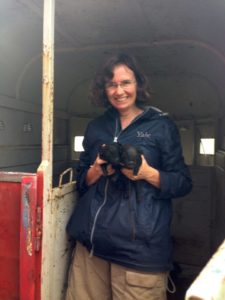 Finally, a series of personal crises got me to think much harder and better about what I wanted out of life, who I am and want to be, and what there is and isn’t time for in a lifetime. I realized that there isn’t time for a career that is draining all your energy, and there isn’t going to be time to do what you really care about some time later—you could get hit by a bus or diagnosed with a chronic debilitating disease before ever getting a chance to do the thing that matters. In addition, I could feel the atrophy in my body from sitting at a desk or standing in front of a lecture hall all day, and I could tell that if I waited another 20 years to start farming, I wasn’t physically going to be able to do it.
Finally, a series of personal crises got me to think much harder and better about what I wanted out of life, who I am and want to be, and what there is and isn’t time for in a lifetime. I realized that there isn’t time for a career that is draining all your energy, and there isn’t going to be time to do what you really care about some time later—you could get hit by a bus or diagnosed with a chronic debilitating disease before ever getting a chance to do the thing that matters. In addition, I could feel the atrophy in my body from sitting at a desk or standing in front of a lecture hall all day, and I could tell that if I waited another 20 years to start farming, I wasn’t physically going to be able to do it.
One of the things that was really missing from my academic life was the satisfaction of physically producing things, of being creative, and of seeing direct results of my work. Having an article appear in an academic journal 12 months after you finish writing it was just not all that satisfying to me! Usually by that time, I’d stopped giving a hoot about what the article even said.
My husband and I also went through a gradual process of becoming much more aware of where our food was coming from and how it was produced. Michael grew up in New York City, in a family that hadn’t grown its own food for several generations. When I started to grow food in the garden while I was still an academic, it was a real revelation to him—eating real ripe tomatoes, discovering that he actually likes beets, starting to understand the difference between the flavor of something like asparagus when it’s just-picked versus transported from Chile.
Around that time, we also started paying attention to the stories that were starting to be published about conditions for animals in factory farming. (Among other things, like so many other people around that time, we read Michael Pollan’s books.) Michael would have been willing to give up meat over what he was learning, but I am way too much of a meat lover ever to do that! Instead, we started buying from local pastured meat and egg producers who sold at our farmers market and decided that we would pay more and possibly eat somewhat less in order to know that the animals were treated humanely.
It took me a little longer really to understand the ways in which the row cropping going on all around us was also a profoundly damaging industrial system that I wanted to resist. But living in the midst of conventional soy and corn country, watching the chemicals being applied to the fields, watching the incredible erosion of this amazing soil (and the attendant runoff of all those chemicals into the waterways), I gradually became more and more appalled by plant-based industrial agricultural as well as factory animal farming. This abundant Midwestern land and deep topsoil was not being used to feed people at all, but was producing commodity crops for ethanol, animal feed, and all kinds of hyper-processed, not-very-nutritional food-like products.
My farming goal is to produce nutrient dense “healthy and happy” food for my family and others using systems that are humane and regenerative.
What kind of training did you have as a farmer?
I had a very modest amount of knowledge going in to this initially. I had grown up in the country, had gardened with my mom, and had a horse and laying hens when I was a kid, so I was comfortable around animals. But I had never grown for production or even done 4-H. When I was ready to move back to the farmhouse and get started, I signed up for The Land Connection’s year-long Farm Beginnings class. You’re probably familiar with this model—we met on Saturdays, every other week or so, starting in October and ending in March. During that time, we got to hear from a wide selection of local farmers who had all different kinds of sustainable operations, and we all worked on business plans for our own farms. In the spring, we each got a farmer mentor through the program who helped us out through the remainder of that year. My mentor, Lisa Haynes from Tomahnous Farm, has remained a mentor and friend even since the formal program ended. She has talked me through “pulling” a lamb over the phone, taught me how to use the elastrator to castrate lambs and kids, and much more.
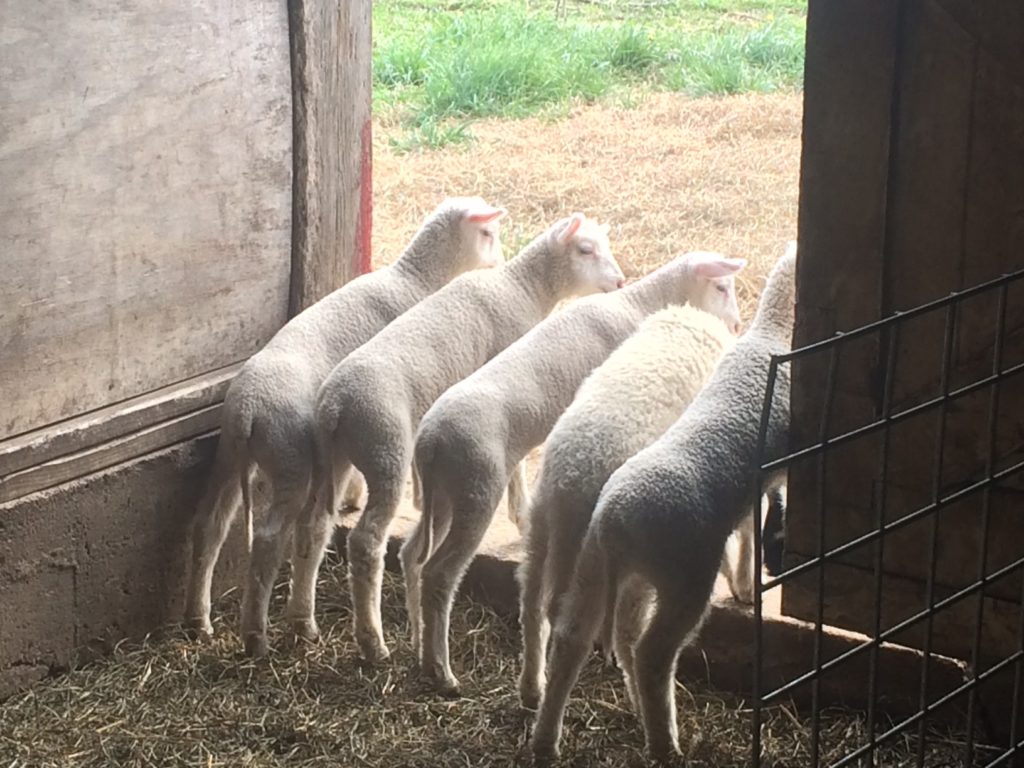
In addition to Farm Beginnings, I am an obsessive reader, and I’ve bought way too many of the Chelsea Green books on farming and permaculture. Even though I’m not really doing much in the way of annual vegetables, I love J.M. Fortier’s book, The Market Gardener. I also really love Michael Phillips’ book on holistic orcharding. More recently, I’ve taken to listening to farming podcasts while I do the animal chores, particularly the Farmer-to-Farmer Podcast and Permaculture Voices.
The one thing I did not do, but I think would have been incredibly valuable, was an internship or apprenticeship on someone else’s farm. Having small kids and already owning my own place for farming made that difficult. I have tried to attend farm field days, as well as workshop type classes on various things from mushroom growing to rotational grazing to small engine repair (many offered by The Land Connection, some offered by extension), and I’ve gone to MOSES once and to our own Illinois specialty crops conference every year.
How have you dealt with the challenges of financing the farm and providing for your own livelihood?
I decided that I wanted to start farming while I still had a full-time job as a university professor. I needed to continue that job for another year after making the decision in order to give my oldest son a chance to finish high school where we were living then, before we moved back here to the farm. So I made a point of setting aside money from my pay for my start-up money for the farm. In addition, in my early days of farming, my mother very generously gave me about $2,000 to help with building permanent fencing to contain my sheep and goats, after she came out for a visit and found me struggling with moving temporary fence every day!
The bigger part of what has made the change possible in my case, though, is that my husband has an off-farm job. Although he’s willing to help with tasks on the farm that require two people now and then, this is really not his thing. We are very fortunate that he is able to provide the family with health insurance as well as the financial stability to deal with my abandoning my previous career, paycheck, and insurance.
My goal for the first few years of the farm was to be able to feed ourselves and cover our animal feed costs and other variable expenses through the money I was making from selling the meat, eggs, and the first fruit/vegetables. I didn’t expect to be able also to cover the fixed costs of some of the longer-term start-up capital expenditures. That has turned out to be about right—I’ve been breaking even, and we’ve been eating really well, but so far I haven’t really been making a profit.
The next step is going to be a bit different from what I first expected. Since we started this farm (and since her help with the money for fencing), my mom died. My husband and I have decided to buy out my sisters’ interest in the farmhouse and land that she owned (where I grew up) in Connecticut. Next summer, we will be moving back there with our family, and I will be starting all over again with planting fruit trees and building fences. It’s going to be hard to leave this little farm, especially as the fruit is just coming into production this year, but the chance to be on 78 acres in the house I grew up in (and closer to other family) was too good to miss.
What changes would you like to see in agri/food culture right now?
When I first moved to Central Illinois (as an assistant professor, with only the dimmest of farm dreams) in 2002, although I had had vegetable gardens and knew how to cook and preserve food, I had very little sense of the overall food system in the US, and very little concern about what was wrong with it. I shopped at the farmers’ market in Urbana when I could, but I didn’t worry much about monocultures of plants or factory farming of animals. As I noted above, my view of conventional farming has changed substantially since then. When I look out over the conventional corn and soy fields around us now, I now see devastation instead of a bucolic country scene. Now I know that the fact that there is bare dirt there from October until May means there’s erosion and runoff. And I know that the fact that there always perfectly bare dirt between the rows of corn and soy means that the fields have been doused in Roundup to kill all the weeds that ought to be there. And I know that the organic matter in that soil is declining year after year, until the soil itself is practically dead and the only thing keeping the corn growing is the fossil-fuel-based fertilizers.
So I guess I’d like to see changes in all of those practices, but I’m not terribly hopeful, given the power of Big Ag. Instead, I think we just have to keep growing and raising good food and particularly showing people that it’s not hard. I think a huge part of what happened over the course of the 20th century was a kind of conspiracy (not trying to be tin-foil hat about this) to convince people that growing food and farming was Terribly Hard Work, that it was a Much Better Life For You to work nine to five in an office, that kids who were good at school should of course become professionals, that farming was for people who weren’t too bright. We have raised two to three generations now of people who have no idea how food grows, or how livestock animals should live and behave. The alienation from these processes creates a population that has no idea how to take care of themselves and no idea what’s wrong with the way industrial agriculture is doing things. I think anything we can do to put people back in touch with where food comes from is good, from gardens in schools to pick-your-own farms to community gardens and food forests in city parks to CSAs and farmers’ markets. A lot more people should be producing food, and even those who may choose not to actually grow it themselves need to be closer to those who do grow it, if we want people and animals and soil all to be healthy and thriving.
Photos courtesy of Katie Kenney.

